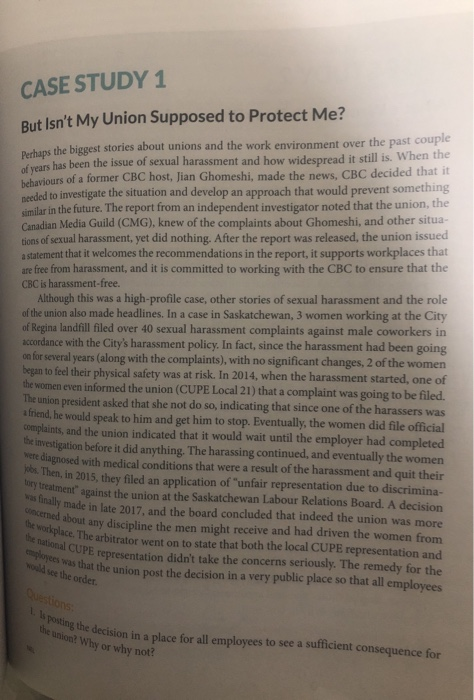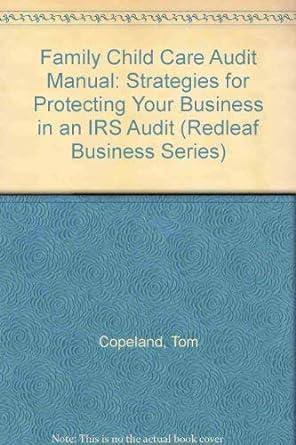cerned about any discipline the men might receive and had driven the women from the workplace. The arbitrator went on to state that both the local CUPE representation and the national CUPE representation didn't take the concerns seriously. The remedy for the employees was that the union post the decision in a very public place so that all employees is posting the decision in a place for all employees to see a sufficient consequence for The union? Why or why not? CASE STUDY 1 But Isn't My Union Supposed to Protect Me? Perhaps the biggest stories about unions and the work environment over the past couple of years has been the issue of sexual harassment and how widespread it still is. When the behaviours of a former CBC host, Jian Ghomeshi, made the news, CBC decided that it needed to investigate the situation and develop an approach that would prevent something similar in the future. The report from an independent investigator noted that the union, the Canadian Media Guild (CMG), knew of the complaints about Ghomeshi, and other situa- tions of sexual harassment, yet did nothing. After the report was released, the union issued a statement that it welcomes the recommendations in the report, it supports workplaces that are free from harassment, and it is committed to working with the CBC to ensure that the CBC is harassment-free. Although this was a high-profile case, other stories of sexual harassment and the role of the union also made headlines. In a case in Saskatchewan, 3 women working at the City of Regina landfill filed over 40 sexual harassment complaints against male coworkers in accordance with the City's harassment policy. In fact, since the harassment had been going on for several years (along with the complaints), with no significant changes, 2 of the women began to feel their physical safety was at risk. In 2014, when the harassment started, one of the women even informed the union (CUPE Local 21) that a complaint was going to be filed. The union president asked that she not do so, indicating that since one of the harassers was a friend, he would speak to him and get him to stop. Eventually, the women did file official complaints, and the union indicated that it would wait until the employer had completed the investigation before it did anything. The harassing continued, and eventually the women were diagnosed with medical conditions that were a result of the harassment and quit their b. Then, in 2015, they filed an application of unfair representation due to discrimina- wey treatment against the union at the Saskatchewan Labour Relations Board. A decision was finally made in late 2017, and the board concluded that indeed the union was more would see the order 2. Should there be consequences for the employer for not dealing with the matter sooner? Why or why not? 3. What should the union do now? Explain your answer. Sources: Adapted from Janice Rubin and Parisa Nikfarjam, "Report:CBC Workplace Investigation regarding Jian Ghomeshi." April 13, 2015; "The Canadian Media Guild Committed to Working with CBC to Ensure a safe and Harassment-Free Work place. The Canadian Media Guild, April 16, 2015, accessed April 14, 2018, www.cmg.ca/erv/2015/04/16/the-canadian -media-guild-committed-to-working-with-cbc to ensure-a-safe-and-harassment-free workplace: "Union Discriminated - Other 21 2017 and Anni cerned about any discipline the men might receive and had driven the women from the workplace. The arbitrator went on to state that both the local CUPE representation and the national CUPE representation didn't take the concerns seriously. The remedy for the employees was that the union post the decision in a very public place so that all employees is posting the decision in a place for all employees to see a sufficient consequence for The union? Why or why not? CASE STUDY 1 But Isn't My Union Supposed to Protect Me? Perhaps the biggest stories about unions and the work environment over the past couple of years has been the issue of sexual harassment and how widespread it still is. When the behaviours of a former CBC host, Jian Ghomeshi, made the news, CBC decided that it needed to investigate the situation and develop an approach that would prevent something similar in the future. The report from an independent investigator noted that the union, the Canadian Media Guild (CMG), knew of the complaints about Ghomeshi, and other situa- tions of sexual harassment, yet did nothing. After the report was released, the union issued a statement that it welcomes the recommendations in the report, it supports workplaces that are free from harassment, and it is committed to working with the CBC to ensure that the CBC is harassment-free. Although this was a high-profile case, other stories of sexual harassment and the role of the union also made headlines. In a case in Saskatchewan, 3 women working at the City of Regina landfill filed over 40 sexual harassment complaints against male coworkers in accordance with the City's harassment policy. In fact, since the harassment had been going on for several years (along with the complaints), with no significant changes, 2 of the women began to feel their physical safety was at risk. In 2014, when the harassment started, one of the women even informed the union (CUPE Local 21) that a complaint was going to be filed. The union president asked that she not do so, indicating that since one of the harassers was a friend, he would speak to him and get him to stop. Eventually, the women did file official complaints, and the union indicated that it would wait until the employer had completed the investigation before it did anything. The harassing continued, and eventually the women were diagnosed with medical conditions that were a result of the harassment and quit their b. Then, in 2015, they filed an application of unfair representation due to discrimina- wey treatment against the union at the Saskatchewan Labour Relations Board. A decision was finally made in late 2017, and the board concluded that indeed the union was more would see the order 2. Should there be consequences for the employer for not dealing with the matter sooner? Why or why not? 3. What should the union do now? Explain your answer. Sources: Adapted from Janice Rubin and Parisa Nikfarjam, "Report:CBC Workplace Investigation regarding Jian Ghomeshi." April 13, 2015; "The Canadian Media Guild Committed to Working with CBC to Ensure a safe and Harassment-Free Work place. The Canadian Media Guild, April 16, 2015, accessed April 14, 2018, www.cmg.ca/erv/2015/04/16/the-canadian -media-guild-committed-to-working-with-cbc to ensure-a-safe-and-harassment-free workplace: "Union Discriminated - Other 21 2017 and Anni








